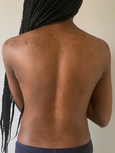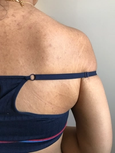How can you treat body acne with light therapy, chemical peels, and laser therapy?
Light therapy (or phototherapy) is an effective treatment option for a handful of skin conditions, from psoriasis to acne, but not often body acne. “Body acne isn’t treated frequently with blue light therapy,” notes Dr. Kellie Reed, a board-certified dermatologist at Westlake Dermatology in Austin, Texas. “It’s more optimal for facial acne.” Dr. Reed recommends blue light therapy for patients who’ve tried more traditional acne treatments that didn’t work, and/or patients who didn’t want to try prescription medications.
You can receive light therapy at your dermatologist’s office—it requires several treatments—or perhaps you’ve seen the Phantom of the Opera-looking at-home masks that glow with blue light and can be used daily for a three-minute treatment. The way light therapy works is by sending targeted wavelengths of red or blue light to areas of the skin, where the light kills bacteria that might later clog the pores and cause a breakout while also slowing sebum (oil) production; it’s also anti-inflammatory. (Ironically, it also makes the skin super sensitive to sunlight.)
Studies have shown light therapy is more effective for acne1 than other laser treatments,2 but there’s still a need for more research to understand how laser treatments work in combination with other acne treatments—and their side effects.3
Chemical peels, which strip the top layer of the (mostly dead) skin to encourage new skin to replace it, aren’t the best treatment for acne but they can be supplemental. The American Academy of Dermatology says peels can mildly improve skin with noninflammatory acne, meaning blackheads/whiteheads that haven’t fully swollen into red pimples, but notes the results aren’t very long-lasting because skin is constantly shedding and re-growing.4
Dr. Reed notes that “peels can be a good adjunct therapy in addition to more traditional acne treatment options, such as oral or topical medications.” Because acne is often a chronic condition that needs long-term, constant treatment, “chemical peels can help speed up results for patients who want to explore additional treatment options.” There’s a whole menu of chemical peels available now (glycolic, lactic, BHA, the list goes on), so talk to your dermatologist to figure out which would be best for your skin.
References:
1Safety and Effectiveness of a New Blue Light Device for the Self-treatment of Mild-to-moderate Acne by Ronald G. Wheeland, MD, FACP and Andrea Koreck, MD, PhDb. J Clin Aesthet Dermatol.
2,4Guidelines of care for the management of acne vulgaris by the Journal of the American Academy of Dermatology.
3Light-based therapies in acne treatment by Susan Pei et al. Indian Dermatol Online J.
Get Updates
There’s more to come.
Sign up to receive periodical updates on Mass Index, and to be the first to know when Soft Services launches new products. (If we don’t have any updates, we won’t email you.)
Body Acne
Breakouts that occur in areas with high concentrations of oil glands.
Also Called
Bacne, blackheads, pimples, pustules, “ass”-ne
Frequently Found On
Back, chest, butt
Related Concerns
Learn More: Body Acne




















